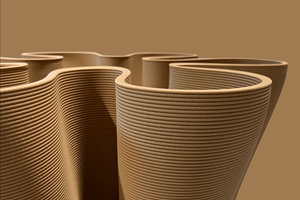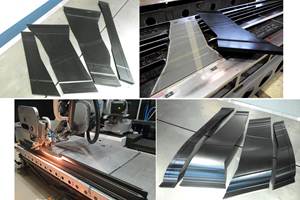Airbus to design, build ESA ExoMars rover lander platform
The resurrected Rosalind Franklin composite rover mission’s key systems will be upgraded with support from the TAS, ESA and NASA for a planned launch in 2028.
Share
An artist’s rendition of the Rosalind Franklin rover. Source | Airbus
Airbus (Toulouse, France) has been selected by the European Space Agency (ESA, Paris, France) and Thales Alenia Space (TAS, Cannes, France) — a joint venture between Thales (67%) and Leonardo (33%) — to build key systems for the ExoMars lander that will safely place the Rosalind Franklin rover on Mars’ surface.
After entry and descent through the Mars atmosphere and a parachute-assisted braking phase, the landing platform provided by Airbus will ensure a safe landing on the surface of Mars and support the deployment of the rover onto the surface ().
The Rosalind Franklin rover was originally designed and built by Airbus in its bio-burden clean room in Stevenage, U.K., and delivered to TAS in 2019, with the original plan for launch in collaboration with Russia’s Roscosmos in 2020. However, delays were extended to 2022, the ESA tells CW, and then, following Russia current activities, the partnership was revoked. Now, a new landing module is being built — of which Airbus is responsible for — which is expected to launch no earlier than 2028.
The ESA confirms that the rover’s composites-intensive design — constructed by Beyond Gravity (Decatur, Ala., U.S. and Bern, Switzerland) and Scheurer Swiss GmbH (Volketswil, Switzerland) — remains unchanged. The top deck of ExoMars RFM’s new landing platform features a sandwich structure with a carbon fiber-reinforced polymer (CFRP) with an aluminum honeycomb core skin. The monopiece skins are manufactured and cured by ADS-Madrid (Spain) and are mono-piece. ADS-UK is responsible for assembling the skins with the aluminum honeycomb.
“Getting the Rosalind Franklin rover onto the surface of Mars is a huge international challenge and the culmination of more than 20 years’ work,” says Kata Escott, managing director of Airbus Defence and Space UK. “The rover will be the first Martian rover able to analyze samples from 2 meters below the surface in its search for past or present life.”
Under contract from TAS, which is leading the Rosalind Franklin mission, Airbus teams in Stevenage, U.K., will design the mechanical, thermal and propulsion systems necessary for the landing platform to ensure the touchdown is safe in 2030. This will include the landing structure, the large propulsion system used to provide the final braking thrust and the landing gear to ensure the lander is stable on touchdown. The lander will feature two ramps that will be deployed on opposite sides to enable the rover to be driven onto the Martian surface using the least risky route.
Airbus teams in Stevenage have designed and built more than 120 propulsion systems for more than 90 spacecraft, providing chemical, electric and cold gas systems for telecoms, Earth observation, science and exploration missions. The ExoMars landing system will need to slow the landing platform from 45 meters/second at the end of the parachute descent phase to less than 3 meters/second before touchdown using retro rockets.
Airbus is working with TAS, ESA and NASA to maintain and upgrade various elements of the Rosalind Franklin rover in preparation for its planned launch in 2028 on a NASA supplied launcher. This includes the accommodation of NASA-provided radioisotope heater units (RHUs) to keep the rover warm on the Martian surface as well as a new software mode to allow the rover to quickly transition into an autonomous state after landing. The rover is planned to touchdown on the surface of Mars in 2030 to avoid landing during the planet’s global dust season.
Related Content
Combining multifunctional thermoplastic composites, additive manufacturing for next-gen airframe structures
The DOMMINIO project combines AFP with 3D printed gyroid cores, embedded SHM sensors and smart materials for induction-driven disassembly of parts at end of life.
Read MorePlant tour: Teijin Carbon America Inc., Greenwood, S.C., U.S.
In 2018, Teijin broke ground on a facility that is reportedly the largest capacity carbon fiber line currently in existence. The line has been fully functional for nearly two years and has plenty of room for expansion.
Read MoreSulapac introduces Sulapac Flow 1.7 to replace PLA, ABS and PP in FDM, FGF
Available as filament and granules for extrusion, new wood composite matches properties yet is compostable, eliminates microplastics and reduces carbon footprint.
Read More3D-printed CFRP tools for serial production of composite landing flaps
GKN Aerospace Munich and CEAD develop printed tooling with short and continuous fiber that reduces cost and increases sustainability for composites production.
Read MoreRead Next
Composites-intensive Perseverance rover makes Jezero Crater milestone
Since its landing on Mars in 2021, NASA’s rover has completed four scientific campaigns. Its fifth campaign up to the crater rim, a location of geologic interest, will further aid scientists’ understanding of Mars’ past formation.
Read MoreFirefly awarded $179 million NASA contract for moon delivery
Company’s third lunar mission and fourth NASA CLPS task order uses Firefly’s carbon fiber Blue Ghost lunar lander, Elytra Dark orbital vehicle and a rover to operate six NASA instruments.
Read MoreVIDEO: High-volume processing for fiberglass components
Cannon Ergos, a company specializing in high-ton presses and equipment for composites fabrication and plastics processing, displayed automotive and industrial components at CAMX 2024.
Read More









